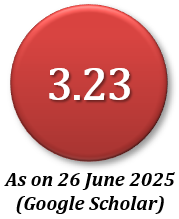Modeling and Control Simulation of a Robotic Chair-Arm: Protection against COVID-19 in Rehabilitation Exercise
Abstract
In the field of rehabilitation, lower-limbs therapeutic exercise has become a challenging job for medical professionals in COVID-19 pandemic. Providing manual therapy to lower limbs is not an easy task and, in most cases, it involves multiple persons. Moreover, it is a monotonous job, and the service providers need to be in close contact with the patient thereby creating the risk of infection. In this circumstance, robot-assisted rehabilitation exercise for lower limbs offers a risk-free solution. This paper presents dynamic modeling and control simulation of One Degree of Freedom robotic chair-arm (robotic arm attached with a special chair). The control structure is designed with two compensators for position and velocity control. The simulation results show that the proposed system has a good potential in providing automatic rehabilitation therapy for lower limbs, especially for knee joint range of motion exercise. The results also indicate faster responses with settling time less than 0.04 second and steady-state error below 0.05. The findings show that a robotic chair arm can be used for providing automatic therapy to patients in situations like COVID-19 pandemic.
Downloads
References
Abdezadeh, S., Saadi, D., Tohidirad, Y., Rashidy, R., & Aliabadi, Z. S. (2016). Hardware Board Design and Simulation of Lower Limb Rehabilitation Robot. Majlesi Journal of Mechatronic Systems (MJMS), 5(3), 1-10.
Akdogan E. and Adli M. A. (2011). The design and control of a therapeutic exercise robot for lower limb rehabilitation: Physiotherabot. Mechatronics, Elsevier Ltd., 21, 509-522.
Akhtaruzzaman, M., & Shafie, A. A. (2010, August 4-7). Modeling and Control of a Rotary Inverted Pendulum Using Various Methods, Comparative Assessment and Result Analysis. Proceedings of the 2010 IEEE International Conference on Mechatronics and Automation, Xi'an, China, 1342-1347.
Akhtaruzzaman, M., Akmeliawati, R., & Yee, T. W. (2009, December 28 – 30). Modeling and Control of a Multi degree of Freedom Flexible Joint Manipulator. Second International Conference on Computer and Electrical Engineering, Dubai, UAE. (pp. 249-254).
Akhtaruzzaman, M., Shafie, A. A., Khan, M. R., & Rahman, M. M. (2019, December 20-22). Knee Joint Kinesiology: A Study on Human Knee Joint Mechanics. 4th International Conference on Electrical Information and Communication Technology (EICT). Khulna, Bangladesh.
Ali, A., Ahmed, S. F., Kadir, K. A., Joyo, M. K., & Yarooq, R. N. S. (2018, May 11-12). Fuzzy PID controller for upper limb rehabilitation robotic system. 2018 IEEE International Conference on Innovative Research and Development (ICIRD), Bangkok, Thailand, (pp. 1-5), doi: 10.1109/ICIRD.2018.8376291.
Bradley, D., Marquez, C., Hawley, M., Brownsell, S., Enderby, P., & Mawson, S. (2009). NeXOS - the design, development, and evaluation of a rehabilitation system for the lower limbs. Mechatronics, 19, 247-257.
Faizura, W. T. W., Luqman, M. Z. M., Hafiz, O. M., Naim, M. S., Armin, S. A., & Irraivan, E. (2020). Control Techniques of Multi-Fingered Hand for Rehabilitation. Journal of Physics: Conference Series, 1532, 012026. doi:10.1088/1742-6596/1532/1/012026
Huang, Y., Nam, C., Li, W., Rong, W., Xie, Y., Liu, Y., Qian, Q., & Hu, X. (2019). A comparison of the rehabilitation effectiveness of neuromuscular electrical stimulation robotic hand training and pure robotic hand training after stroke: A randomized controlled trial. Biomedical Signal Processing and Control, Elsevier Ltd., 56, 1-10.
Hussain, S., Xie, S. Q., & Jamwal, P. K. (2013). Control of a robotic orthosis for gait rehabilitation. Robotics and Autonomous Systems, Elsevier B.V., 61, 911-919.
Joyo, M. K., Raza, Y., Ahmed, S. F., Billah, M. M., Kadir, K., Naidu, K., … Mohd Yusof, Z. (2019). Optimized Proportional-Integral-Derivative Controller for Upper Limb Rehabilitation Robot. Electronics, 8(8), 826. doi:10.3390/electronics8080826
Kimmig, R., Verheijen, R. H. M., Rudnicki, M., & SERGS Council. (2020). Robot assisted surgery during the COVID-19 pandemic, especially for gynecological cancer: a statement of the Society of European Robotic Gynaecological Surgery (SERGS). J Gynecol Oncol, 31(3). doi: 10.3802/jgo.2020.31.e59
Lee, M., Sung, D. J., Lee, J., Oh, I., Kim, S., Kim, S., & Kim, J. (2016). Enhanced knee joint function due to accelerated rehabilitation exercise after anterior cruciate ligament reconstruction surgery in Korean male high school soccer players. Journal of Exercise Rehabilitation, 12(1), 29-36.
Lerner, Z. F., Damiano, D. L., Park, H. S., Gravunder, A. J., & Bulea, T. C. (2016). A Robotic Exoskeleton for Treatment of Crouch Gait in Children with Cerebral Palsy: Design and Initial Application. IEEE Transactions on Neural System & Rehabilitation Engineering. 99, 1-10. doi: 10.1109/TNSRE.2016.2595501.
Moughamir, S., Zaytoon, J., Manamanni, N., & Afilal, L. (2002). A system approach for control development of lower limbs training machines. Control Eng. Pract., 10, 287-299.
Shi, D., Zhang, W., Zhang, W., & Ding, X. (2019). A Review on Lower Limb Rehabilitation Exoskeleton Robots. Chin. J. Mech. Eng. 32(74), 1-11, https://doi.org/10.1186/s10033-019-0389-8
Yang, G. Z., Nelson, B. J., Murphy, R. R., Choset, H., Christensen, H., Collins, S. H., Dario, P., Goldberg, K., Ikuta, K., Jacobstein, N., Kragic, D., Taylor, R. H., & McNutt, M. (2020). Combating COVID-19—The role of robotics in managing public health and infectious diseases, Science Robotics, 5(40), eabb5589, 1-2.
Zeng, Z., Chen, P. J., & Lew, A. A. (2020). From hightouch to high-tech: COVID-19 drives robotics adoption. Tourism Geographies. 22(3), 724-734, doi: 10.1080/14616688.2020.1762118
MIJST follows the open access policy.

This work is licensed under a Creative Commons Attribution-NonCommercial 4.0 International License. This allows anyone to copy, share, distribute, and modify the work for non-commercial purposes, where the original work and source should be properly credited.
















